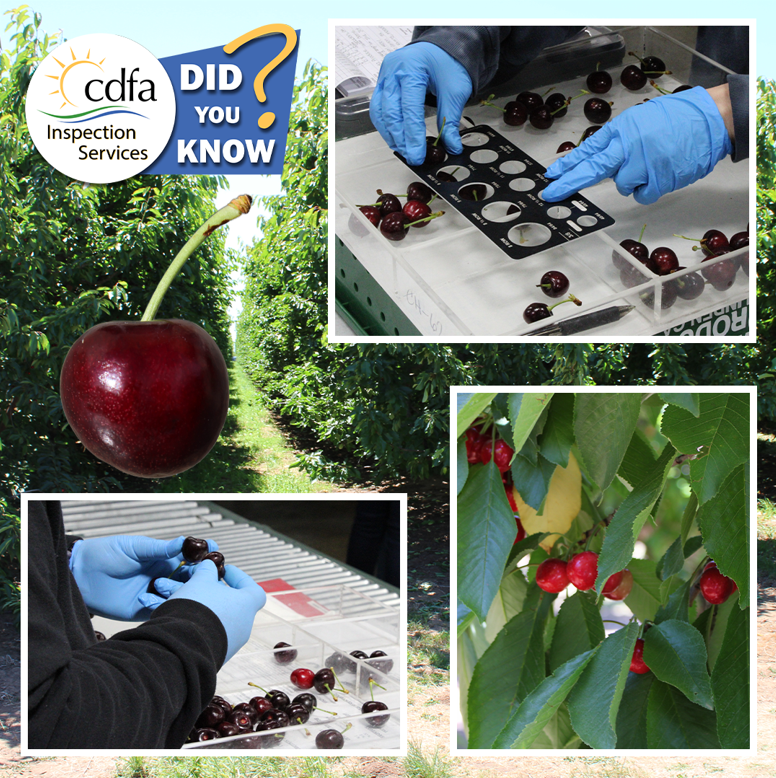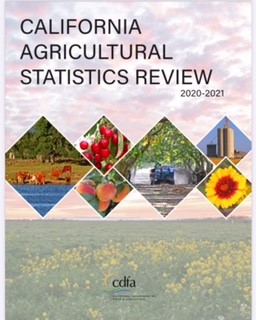-
Recent Posts
- CDFA Undersecretary Christine Birdsong counts down California CRUNCH!
- Celebrating Hispanic Heritage Month – California Farmer Mel Resendiz
- Secretary Ross on Water, Workforce, and the Future of California Agriculture — from AgNet West
- Agritourism – the Central Valley’s Best Pumpkin Patches
- Farm-to-School Month Grantee Spotlight: Santa Ana Unified
Recent Comments
- CA agriculture value surpasses $60B | Western Livestock Journal on Value of California Ag production tops $60 billion for first time
- Kathy de Contreras on CDFA IT department honored at “Best of California” awards
- El costo económico de las deportaciones masivas ya es visible en California - Espanol News on Nine California Counties Make Top-10 List for Ag Sales in the U.S.
- Deportations are taking a toll on California’s economy – and have only just begun – The News Beyond Detroit on Nine California Counties Make Top-10 List for Ag Sales in the U.S.
- Kenneth Cooper McNany on California Agricultural Heritage Club seeks nominations to honor pioneering farms and ranches more than 100 years old
Archives
- October 2025
- September 2025
- August 2025
- July 2025
- June 2025
- May 2025
- April 2025
- March 2025
- February 2025
- January 2025
- December 2024
- November 2024
- October 2024
- September 2024
- August 2024
- July 2024
- June 2024
- May 2024
- April 2024
- March 2024
- February 2024
- January 2024
- December 2023
- November 2023
- October 2023
- September 2023
- August 2023
- July 2023
- June 2023
- May 2023
- April 2023
- March 2023
- February 2023
- January 2023
- December 2022
- November 2022
- October 2022
- September 2022
- August 2022
- July 2022
- June 2022
- May 2022
- April 2022
- March 2022
- February 2022
- January 2022
- December 2021
- November 2021
- October 2021
- September 2021
- August 2021
- July 2021
- June 2021
- May 2021
- April 2021
- March 2021
- February 2021
- January 2021
- December 2020
- November 2020
- October 2020
- September 2020
- August 2020
- July 2020
- June 2020
- May 2020
- April 2020
- March 2020
- February 2020
- January 2020
- December 2019
- November 2019
- October 2019
- September 2019
- August 2019
- July 2019
- June 2019
- May 2019
- April 2019
- March 2019
- February 2019
- January 2019
- December 2018
- November 2018
- October 2018
- September 2018
- August 2018
- July 2018
- June 2018
- May 2018
- April 2018
- March 2018
- February 2018
- January 2018
- December 2017
- November 2017
- October 2017
- September 2017
- August 2017
- July 2017
- June 2017
- May 2017
- April 2017
- March 2017
- February 2017
- January 2017
- December 2016
- November 2016
- October 2016
- September 2016
- August 2016
- July 2016
- June 2016
- May 2016
- April 2016
- March 2016
- February 2016
- January 2016
- December 2015
- November 2015
- October 2015
- September 2015
- August 2015
- July 2015
- June 2015
- May 2015
- April 2015
- March 2015
- February 2015
- January 2015
- December 2014
- November 2014
- October 2014
- September 2014
- August 2014
- July 2014
- June 2014
- May 2014
- April 2014
- March 2014
- February 2014
- January 2014
- December 2013
- November 2013
- October 2013
- September 2013
- August 2013
- July 2013
- June 2013
- May 2013
- April 2013
- March 2013
- February 2013
- January 2013
- December 2012
- November 2012
- October 2012
- September 2012
- August 2012
- July 2012
- June 2012
- May 2012
- April 2012
- March 2012
- February 2012
- January 2012
- December 2011
- November 2011
- October 2011
- September 2011
- August 2011
- July 2011
- June 2011
Categories
- AG Vision
- Agricultural Education
- Agricultural Marketing
- Alternative Fuels
- Animal health
- Animal Welfare
- Asian Citrus Psyllid
- Biodiversity
- Border stations
- BSE
- Cannabis
- Cannella Panel
- Climate Change
- Climate Smart Agriculture
- Community-based Food System
- Conservation
- Dairy
- Drought
- Environment
- Fairs
- Farm Bill
- Farm Labor
- Farmers' Markets
- Fertilizer
- Food Access
- Food Safety
- Food Waste
- Glassy-winged Sharpshooter
- Growing California
- Healthy soils
- HLB
- Hydrogen
- Integrated Pest Management (IPM)
- Invasive Species
- Light Brown Apple Moth
- Livestock ID
- Measurement Standards
- Nutrition
- Organic agriculture
- Pierce's Disease
- Pollinators
- Specialty Crops
- State Board of Food and Agriculture
- Succession Planning
- Trade
- Uncategorized
Pages

National Learn About Compost Day coming up this weekend — CDFA offers compost resources page
Posted in Uncategorized
Leave a comment
Department of Conservation announces $42 million in Land Repurposing Program Grants
From a California Department of Conservation News Release
The California Department of Conservation today announced the award of more than $40 million to regional organizations working to reduce groundwater reliance and create local environmental and economic opportunities through land-use changes. These organizations, which operate in five important agricultural counties, are the first recipients of funding from the Multibenefit Land Repurposing Program, part of Governor Newsom’s multi-faceted response to the ongoing drought.
Grant recipients
- The Kaweah Delta Water Conservation District was awarded $10 million to develop a comprehensive land repurposing program in a groundwater subbasin that has been designated as critically over-drafted by the Department of Water Resources (DWR).
- The Pixley Irrigation District Groundwater Sustainability Agency, which operates in Tulare County and a portion of Kern County, received $10 million to facilitate strategic land retirement, develop habitat resources, and protect and enhance water resources in the Tule subbasin.
- The California Marine Sanctuary Foundation, headquartered in Monterey, was granted $10 million to fund land repurposing work by a broad coalition, including disadvantaged communities and tribes.
- The County of Madera received $10 million in funding to pay farmers to repurpose marginal agricultural lands in three critically over-drafted subbasins with historical groundwater level declines, land subsidence, and groundwater quality degradation.
- Visalia-based Self-Help Enterprises and the Environmental Defense Fund’s California Water team were awarded $2 million grant to provide support for the program’s block grantees with planning, project implementation, and community engagement services.
About the Program The Budget Act of 2021 allocated the California Department of Conservation $50 million to fund groundwater sustainability projects that reduce groundwater use, repurpose irrigated agricultural land, and provide wildlife habitat. For more information, visit the MLRP webpage.
Posted in Uncategorized
Leave a comment
USDA announcement for Commodity Container Assistance Program includes Port of Oakland
From a USDA news release
USDA Secretary Tom Vilsack announced that the U.S. Department of Agriculture (USDA) will begin accepting applications for the Commodity Container Assistance Program (CCAP), which currently includes a partnership with the Port of Oakland and the Northwest Seaport Alliance (NWSA), which is a marine cargo operating partnership between the Port of Seattle and the Port of Tacoma in Washington State.
Ongoing market disruptions have created logistical challenges associated with the availability and flow of shipping containers to transport agricultural commodities, which has prevented or delayed American-grown agricultural commodities from reaching their markets.
“Both the Port of Oakland and the NWSA in Seattle have been identified as key gateways for American-grown agricultural commodities, and each has experienced significant challenges with the flow of containerized agricultural commodities and products,” Secretary Vilsack said. “While USDA’s per-container reimbursements will not cover the full cost of moving and storing shipping containers, the assistance provided will help ensure American-grown agricultural products can once again efficiently move through supply chains to reach global markets.”
Port of Oakland
Fewer shipping containers have been made available for U.S. agricultural commodities as ocean carriers have circumvented traditional marketing channels and rushed containers back to be exported empty and, as a result, many of these carriers have suspended service to the Port of Oakland.
The Howard Terminal “pop up” site in the Port of Oakland will provide space to prepare empty containers. Agricultural companies and cooperatives will have easier access to these containers, which they can fill with commodities, which will help restoreshipping services to agricultural commodities while relieving congestion.
For the Port of Oakland, the Agricultural Marketing Service covered 60% of the start-up costs for the “pop up” site and under CCAP the Farm Service Agency (FSA) is providing a $125 per container payment to partially assist agricultural commodity owners for the additional logistical expenses associated with picking up empty shipping containers to be filled with agricultural commodities and products at the Port of Oakland. Under CCAP FSA will also provide payments of $200 per dry container and $400 per refrigerated, or reefer, container to help cover additional logistical costs associated with moving the shipping container twice, first to the preposition site and then to the terminal loading the vessel, along with the cost of temporary storage.
How to Apply
The Farm Service Agency (FSA) will make monthly direct payments to agricultural companies and cooperatives on a per-container basis based upon the location of the port, and the type of shipping container, including empty containers, dry filled containers, and reefer filled containers. Both sites will have the ability to pre-cool refrigerated shipping containers to receive perishable commodities.
To apply for CCAP, applicants must complete form FSA-862, Commodity Container Assistance Program (CCAP) Application according to FSA-862 instructions and submit the form to the FSA National Office by email to SM.FPAC.FSA.CCAP@usda.gov. Payments will be made in arrears and verified with terminal records. Applicants may submit applications on a monthly basis, but all applications must be submitted by Jan. 31, 2023.
Posted in Agricultural Marketing, Specialty Crops, Trade, Uncategorized
Tagged Ag exports, agriculture, exports, shipping, USDA
Leave a comment
CDFA Border Stations helping to prevent risk of invasive mussel infestation during boating season
Once again, CDFA is partnering with the California Department of Fish and Wildlife, California State Parks, and the Department of Water Resources to help prevent invasive quagga and zebra mussels from entering California. Staff at CDFA Border Inspection Stations are inspecting boats and other watercraft entering the state for unwanted hitchhikers.
Boaters are urged to take the following steps to help prevent the spread of mussels:
- CLEAN — inspect exposed surfaces and remove all plants and organisms.
- DRAIN — all water, including water contained in lower outboard units, live-wells and bait buckets.
- DRY — allow the watercraft to thoroughly dry between launches. Watercraft should be kept dry for at least five days in warm weather and up to 30 days in cool weather.
CDFA has inspected more than two-million watercraft since an expanded focus on invasive mussels began nearly 15 years ago.
See this link for more information about quagga and zebra mussels.
Posted in Border stations, Environment, Invasive Species, Uncategorized
Tagged boating, mussels, waterways
Leave a comment
CDFA helps ensure that California cherries meet industry standards and consumer expectations

Did you know that CDFA’s Shipping Point Inspection Program conducts cherry inspections at packing houses to help ensure that California cherries meet state and national standards? Packing houses are hard at work this month to get freshly-picked California cherries to consumers worldwide.
Packing house inspectors must go through 40 initial hours of training–and eight additional hours annually–to receive a USDA license to properly inspect California cherries for quality, size, maturity and firmness. Cherries are separated by size and quality and packaged for distribution.
The Shipping Point Inspection Program is part of the Inspection and Compliance Branch in CDFA’s Division of Inspection Services.
Posted in Agricultural Marketing, Growing California, Specialty Crops, Trade, Uncategorized
Tagged agriculture, Cherries
Leave a comment
Cal/OSHA reminds employers to protect outdoor workers from heat illness
From a Cal/OSHA news release
Cal/OSHA reminds all employers with outdoor workers to be prepared and take the necessary precautions to prevent heat illness, as high temperatures are expected throughout the state this week. Employers in California must take steps to protect outdoor workers from heat illness by providing water, rest, shade and training.
“As we shift towards summer, employers need to ensure they have updated their written heat plans and provided effective training to all of their employees who work outdoors,” said Cal/OSHA Chief Jeff Killip. “For those who want help, Cal/OSHA is ready and available to provide consultation and outreach.”
Cal/OSHA’s heat illness prevention standard applies to all outdoor worksites. To prevent heat illness, the law requires employers to provide outdoor workers fresh water, access to shade at 80 degrees and whenever requested by a worker, cool-down rest breaks in addition to regular breaks and maintain a written prevention plan with training on the signs of heat illness and what to do in case of an emergency.
- Plan – Develop and implement an effective written heat illness prevention plan that includes emergency response procedures.
- Training – Train all employees and supervisors on heat illness prevention.
- Water – Provide drinking water that is fresh, pure, suitably cool and free of charge so that each worker can drink at least 1 quart per hour, and encourage workers to do so.
- Rest – Encourage workers to take a cool-down rest in the shade for at least five minutes when they feel the need to do so to protect themselves from overheating. Workers should not wait until they feel sick to cool down.
- Shade – Provide proper shade when temperatures exceed 80 degrees. Workers have the right to request and be provided shade to cool off at any time.
Cal/OSHA’s Heat Illness Prevention special eDOmphasis program includes enforcement of the heat regulation as well as multilingual outreach and training programs for California’s employers and workers. Details on heat illness prevention requirements and training materials are available online on Cal/OSHA’s Heat Illness Prevention web page and the 99calor.org informational website. A Heat Illness Prevention online tool is also available on Cal/OSHA’s website.
Cal/OSHA helps protect workers from health and safety hazards on the job in almost every workplace in California. Employers who have questions or want assistance with workplace health and safety programs can call Cal/OSHA’s Consultation Services Branch at 800-963-9424.
Workers who have questions about heat illness prevention can call 833-579-0927 to speak with a Cal/OSHA representative during normal business hours. Complaints about workplace safety and health hazards can be filed confidentially with Cal/OSHA district offices.
Posted in Farm Labor, Uncategorized
Tagged agriculture, Extreme Heat, Farmworkers, Worker safety
Leave a comment
Secretary Ross tours San Francisco wholesale produce market
CDFA Secretary Karen Ross, CDFA Inspection Services Director Natalie Krout-Greenberg, and California State Senator Scott Wiener (D-San Francisco) visited San Francisco’s SF Market early this morning (May 20) to learn how the Market–a wholesale produce market–provides food and relationships that help businesses, Bay Area communities, and hundreds of farmers thrive. The SF Market is home to 26 merchants moving millions of pounds of fresh produce annually through the Bay Area. The Market also offers programs directed toward healthy food access and food waste reduction.
Secretary Ross applauds appointment of Maria Gallegos Herrera as USDA Rural Development State Director for California
President Biden has appointed Maria Gallegos Herrera as the USDA’s Rural Development State Director for California. Herrera grew up in the Central Valley, the daughter of farmworker parents, and served Governor Gavin Newsom’s administration as Central California Regional Director of External Affairs.
“I want to offer my most sincere congratulations to Maria on her appointment,” said CDFA Secretary Karen Ross. “She is a thoughtful, dedicated champion for our rural communities and farmworker families, and I know she will work tirelessly to bring investment in infrastructure and economic development to our most underserved rural areas.”
Herrera worked at CDFA early in her career, serving as an agricultural aide from 2004-2007.
CDFA releases annual Ag stats report
The annual California Agricultural Statistics Review has been released and is available on the following webpage: https://www.cdfa.ca.gov/Statistics/. This publication provides comprehensive data and information on California’s diverse agricultural economy for the 2020 crop year, including agricultural exports and organic production.
In 2020, California’s farms, ranches and plant nurseries earned $49.1 billion in cash receipts, which was down 3.3 percent from the prior year. California’s revenue was led by the dairy industry, followed by almonds, grapes and pistachios.
California agricultural exports totaled $20.8 billion in value, which was 2.8 percent lower than 2019. However, California continues to lead the nation in agricultural exports. In 2020, California exported approximately 32 percent of its agricultural production by volume. California is the nation’s sole exporter of many agricultural products, supplying 99 percent or more of almonds, artichokes, dates, figs, garlic, kiwifruit, olives and olive oil, pistachios, prunes, raisins, table grapes, tomatoes for processing, and walnuts.
California organic product sales totaled more than $11.9 billion in 2020, an increase of 14 percent from the prior year. Organic production site acreage increased 6 percent to just under 2.2 million acres in the state. California accounts for 36 percent of all organic production in the U.S.
California remained the leading state in cash farm receipts in 2020 with combined commodities representing 13.7 percent of the U.S. total. Over a third of the country’s vegetables and two-thirds of the country’s fruits and nuts are grown in California. California’s top-10 valued commodities for the 2020 crop year are:
- Milk and Cream $7,466,612,000
- Almonds $5,619,930,000
- Grapes $4,481,297,000
- Pistachios $2,873,750,000
- Cattle and Calves $2,737,342,000
- Lettuce, all $2,275,284,000
- Berries, all Strawberries $1,989,170,000
- Tomatoes, all $1,197,026,000
- Floriculture $967,206,000
- Walnuts $957,700,000
Note: A comprehensive report for the 2021 crop year will be assembled in late 2022. Data on California’s Top 10 Agricultural Commodities are reported and updated each August.
Posted in Uncategorized
1 Comment
USDA accepting applications for assistance with organic costs
Agricultural producers and handlers who are certified organic, along with producers and handlers who are transitioning to organic production, can now apply for the U.S. Department of Agriculture’s (USDA) Organic and Transitional Education Certification Program (OTECP) and Organic Certification Cost Share Program (OCCSP), which help producers and handlers cover the cost of organic certification, along with other related expenses. Applications for OTECP and OCCSP are both due October 31, 2022.
“By helping with organic certification costs – long identified as a barrier to certification – USDA has helped producers participate in new markets while investing in the long-term health of their operations,” said Farm Service Agency Administrator Zach Ducheneaux. “We launched the Organic and Transitional Education Certification Program to build on the support offered through the Organic Certification Cost Share Program and provide additional assistance to organic and transitioning producers weathering the continued market impacts of the COVID-19 pandemic. This year, in response to stakeholder feedback, we have aligned the signup dates for these two organic programs and encourage producers to work with the local USDA Service Centers and State agencies to complete the applications. The FSA, and the USDA broadly, are committed to making sure our Nation’s organic producers and handlers have the tools they need to continue positively shaping our local and regional food systems.”
How to Apply
To apply, producers and handlers should contact the Farm Service Agency (FSA) at their local USDA Service Center. As part of completing the OCCSP applications, producers and handlers will need to provide documentation of their organic certification and eligible expenses. Organic producers and handlers may also apply for OCCSP through participating State agencies.
Additional details can be found on the OTECP and OCCSP webpages.
Posted in Uncategorized
Leave a comment



